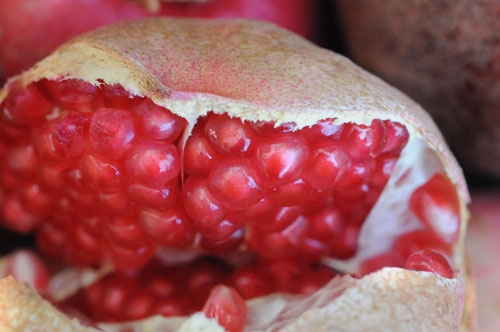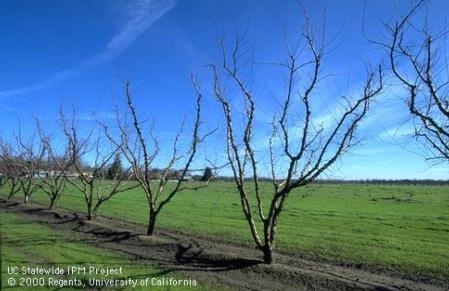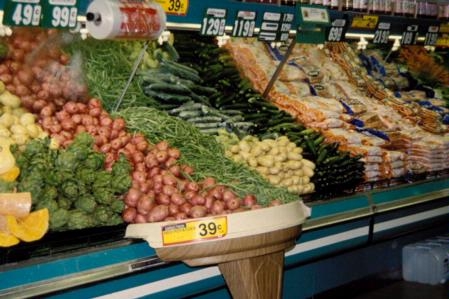Posts Tagged: Joe Grant
Northern San Joaquin Valley is basking in the cold
During the recent cold snap in California, the media turned to UC Cooperative Extension advisors for information on the weather's impact on agricultural production in the Northern San Joaquin Valley.
The consensus for this part of the state: cold weather is good news. The Stockton Record checked in with Joe Grant, UC Cooperative Extension advisor in San Joaquin County.
"We'll take any and all cold that we can at this time of year to fulfill the chilling requirements of the trees," Grant said.
Paul Verdegaal, UCCE advisor in San Joaquin County, a viticulture expert, agreed.
"The good side of the story is we're catching up on the chilling hours, which will produce a good strong bud bread and bloom for all the perennial crops," Verdegaal said. "(Subfreezing temperatures, however,) may be hurting some younger trees and vines, but generally, things are in dormancy, so it's not too much of a problem."
Maxwell Norton, UCCE advisor in Merced County, spoke to the Merced Sun-Star.
"For us out here, the cold nights are good," Norton said. "We fare quite well because we don't grow subtropical crops like citrus and avocados."
Scott Stoddard, UCCE advisor in Merced County, said crop storage facilities need to pay attention to temperature control when the weather gets very cold.
"We have a lot of sweet potatoes in storage," he said. "They guys need to make sure their storage rooms are working properly and don't get too cold."
Roger Duncan, UCCE advisor in Stanislaus County, told the Modesto Bee that warm winters are more harmful than cold snaps such as the one we're experiencing.
"Actually, this is beautiful," Duncan said. "Tree crops need cold in order to break their rest."
Climate change will likely impact the grocery store produce aisle
- Cherries, said reporter Mark Schapiro, are the canary in the climate coalmine for California tree crops. "They're highly sensitive to changes in temperature and rainfall, which scientists say are being altered by climate change," he said.
The segment included comments from Joe Grant, UC Cooperative Extension advisor in San Joaquin County.
He said California cherry growers have traditionally had a competitive edge in the U.S. because their crop ripens early compared to cherries grown by competitors in Oregon, Washington, Michigan and New York.
"The market price for sweet cherries very early in the season is very, very high," Grant said. But now, California's moderate climate may be getting too warm, and cherry production could become unsustainable. - Water was the focus of the second part of the documentary, especially the fact that less water and limited drainage options prevent farmers from leaching salts out of crops' rootzones on the west side of the San Joaquin Valley. The salty environment for an almond grower featured in the segment has prompted him to consider uprooting the trees and replanting with rootstocks that have greater salt tolerance.
- The third segment dealt with tomato-potato psyllid, which has recently begun surviving the winter in areas where it used to be too cold. John Trumble, professor in the Department of Entomology at UC Riverside, said that, in addition to direct feeding damage, the psyllid transmits a disease in potatoes that creates zebra-like markings when they are fried to make chips.
"Some of them come out with wonderful patterns," Trumble said. "But unfortunately, what's happened, instead of starch they have sugar in the vascular system. When you cook that, it turns brown and the consumer sends it back."
View the documentary below:
Farmers find niche in pomegranate production
Growing demand for pomegranate juice, with its many purported health benefits, is increasing farmers' interest in cultivating the drought-resistant crop, according to a story in the Lodi News.
The article featured a new, vertically integrated agribusiness venture being developed by San Joaquin County partners John Ferreira and John Cotta. The team are converting acreage from thirsty alfalfa to a crop cultivated since ancient times in Middle Eastern desert regions.
"I wanted to get away from chemicals and pesticides and high water usage," Ferreira told reporter Jordan Guinn.
The partners are planning to crush their own pomegranates on the farm to produce smooth, not-too-acidic pomegranate juice, pomegranate wine, and even candles, oils and makeup made from the skins, rinds and seeds of pomegranates.
Eating pomegranates fresh never really caught on in the United States. Until demand for juice grew, the pomegranate industry didn't take off, UC Cooperative Extension farm advisor Joe Grant told the reporter. Paramount Farm's POM Wonderful is credited with raising the fruit juice's currency.The San Joaquin Valley's Mediterranean climate provides an excellent environment for pomegranate cultivation.
"They grow like weeds out here," Grant was quoted.

Pomegranate seeds photographed by Kathy Keatley Garvey.
It's a good year for California cherries
With winter winding down, fresh fruit season in California is right around the corner. The first fruit to come off trees in May and June are bing cherries.
The Stockton Record reports today that consumers can expect a bounty of the delicious and healthful fruit. California's cherry growers could produce a record-breaking 10 million 18-pound boxes of fruit this spring, according to the article by Reed Fujii. Last year California cherry growers produced 8.3 million boxes.
Excellent weather and an increasing number of acres planted to cherries is the reason for the projected growth, the story said.
In the past, the focus of the state's cherry industry was San Joaquin County, where orchards benefit from cool night air flowing in from the San Francisco Bay. However, new varieties are being planted farther south in the San Joaquin Valley, where they bloom and ripen sooner.
"In 1990, I'll bet there were absolutely no (cherry) acres south of Madera," the article quoted Joe Grant, UC Cooperative Extension farm advisor in San Joaquin County. "The lion's share of the expansion has been in these early varieties in the earlier areas."
But San Joaquin County still leads the state in cherry production, with 17,700 bearing acres in 2008 producing a crop worth an estimated $170 million, the story said.

Ripe California cherries.



